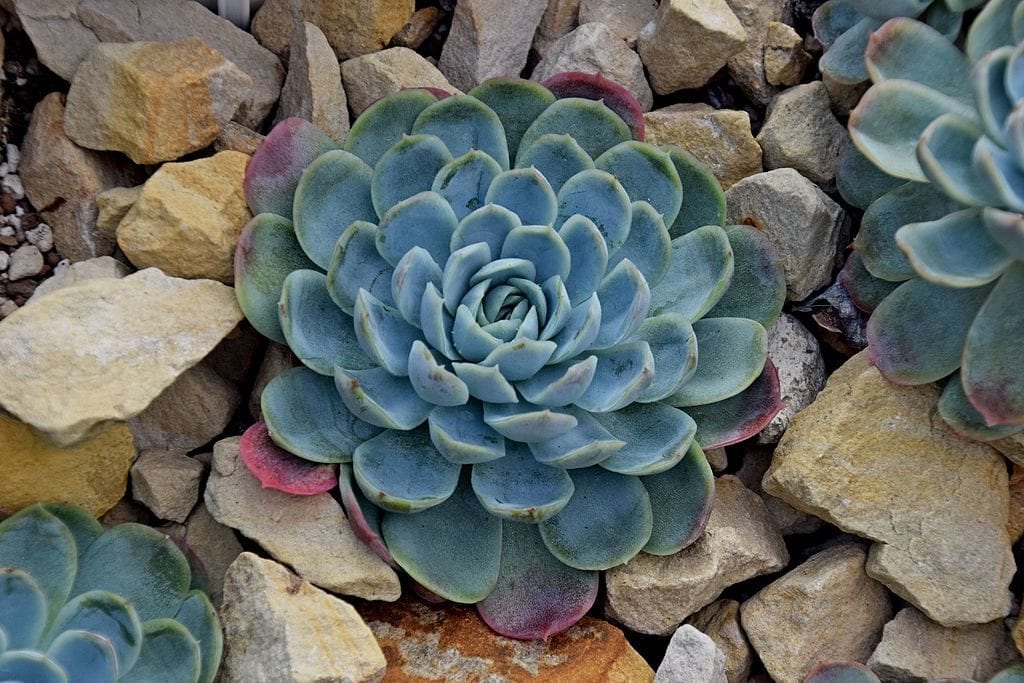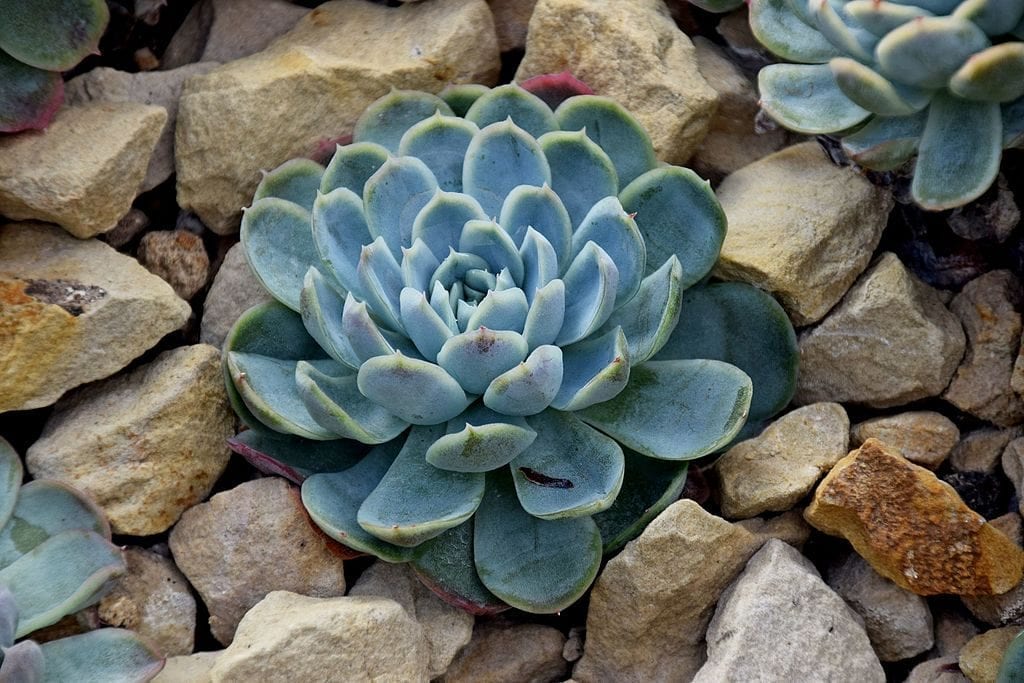
La echeveria elegans It is one of the most common and most beautiful non-cactaceous succulent or succulent plants in the world, so much so that it is known as alabaster rose. And it really looks like an artificial flower, although it produces its own.
It grows quite fast, and the most interesting thing is that it can be grown both in a pot and in the garden. Oh, and it's beginner-friendly. Know her.
Origin and characteristics

Our protagonist is a crassulaceous native of central Mexico, specifically the state of Hidalgo, whose scientific name is Echeveria elegans. It grows forming rosettes of stemless leaves that reach up to 10 centimeters in diameter.. These leaves are round, fleshy, bluish-green in color and usually have a pink border. The flowers are fleshy too, and they come out of a very thin pink stem, and they are also pink.
The plant has a tendency to take out suckers, called stolons, so it is very easy to multiply it. Let's see how it is cared for.
What are their cares?

If you want to have a copy, we recommend that you provide it with the following care:
Location
La echeveria elegans it is a crass plant that must be outside, if possible in an area where it is in direct sunlight all day. Now, you can have it in semi-shade as long as it is exposed to the sun directly at least four hours / day. Of course, regardless of where you put it, get used to the sun little by little to prevent it from burning.
Indoors it does not grow well, unless it is in an interior patio with a glass roof, or in a very bright room (with natural light).
Earth
It can be both in a pot and in the garden, so that the soil will be different in each case:
- Flower pot: universal culture substrate mixed with perlite in equal parts. You can get the first here and the other here.
- Garden: it must have very good drainage. If the soil you have is very compact, don't worry. As it is a rather small plant, you can make a hole large enough to fit a square block -of those that are hollow inside-, insert it in said hole and fill the hole with universal growing substrate mixed with perlite in equal parts.
Irrigation
Succulents such as echeveria elegans they are VERY sensitive to excess watering. Your root system is not able to absorb so much water, not even to be in contact with it for too long. For this reason, It is important that -especially if you don't have much experience taking care of succulents-, you check the humidity of the soil before watering, since you have to let the soil dry completely between one watering and another.
How to do that? Very easy:
- Insert a thin wooden stick to the bottom: if when you remove it, it comes out with a lot of adhering soil, do not water since this will indicate that it is still wet.
- Weigh the pot once watered and again after a few days: Wet soil will always weigh more than dry soil, so this difference in weight will serve as your guide.
- Using a digital moisture meter- Insert it closer to the plant and again further away for 100% reliability.
- Dig about two inches around the plant: so if you see that the earth at that depth is darker than that of the surface, you will know that you should not water yet.
Anyway, to give you an idea, it is advisable to water twice a week in the hottest time of the year, and once a week the rest of the year. During the winter you have to water less: once every 2 or 15 days.
Subscriber

From early spring to late summer It must be paid with specific fertilizers for cacti and other succulents following the indications specified on the product packaging.
Multiplication
La echeveria elegans multiplies by seeds, leaf cuttings and stolons in spring-summer. Let's see how to proceed in each case:
Seeds
What you have to do is:
- Fill a pot of about 10,5cm in diameter with universal growing substrate mixed with perlite in equal parts.
- Water conscientiously, soaking the whole earth well.
- Place the seeds on the surface, ensuring that they are slightly separated from each other.
- Cover them with a thin layer of substrate, and spray with water.
- Place the pot in semi-shade.
Thus, they will germinate in 2 or 3 weeks.
Leaf cuttings
It is very easy to get a new copy from one sheet. For it, you have to take some leaves that are neither old nor new (that they are from the center rows), let the wound dry for a couple of days and then lay them down on a pot with universal culture substrate mixed with 50% perlite. If you want, you can cover the area where the roots will come out, which is the one that was attached to the mother plant, with a little substrate.
In a matter of 1 to 2 weeks they will emit their own roots ... and new leaves.
Stolons
The stolons are to be treated as cuttings. Simply you have to cut the ones that interest you, and plant them in a pot with universal growing substrate. They will emit their own roots in one or two weeks maximum.
Plagues and diseases
It's very tough, but you have to be careful with mealybugs and mollusks, especially with snails. Both pests can be controlled manually: the first can be removed with a brush soaked in pharmacy alcohol, and the others can be caught and carried as far as possible (minimum 400 meters) from the garden, patio or terrace.
Rusticity
From experience I can tell you that it withstands specific frosts of up to -1,5ºC without problems, so surely hold up to -2ºC. If you live in a colder area, it should be protected indoors.

What did you think of echeveria elegans?
pucha I'm from peru but they are pearls you can leave it in a photo or images to buy it and growing substrate please what is it made of, can you help me thanks
Hello Alfredo.
En this article we explain what perlite is 🙂. If you have any further questions, contact us.
Regards!
Hello, what are your references?
Hi Ivonne.
The experience in its cultivation 🙂
If you have any doubts, please contact us.
Greetings.